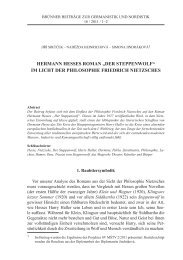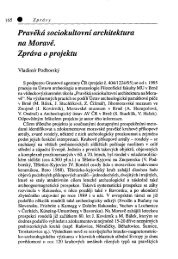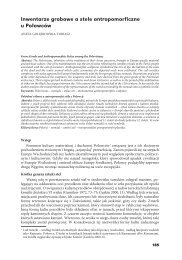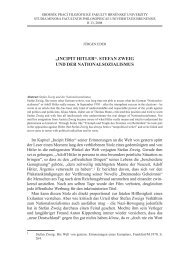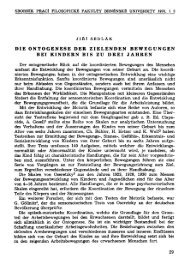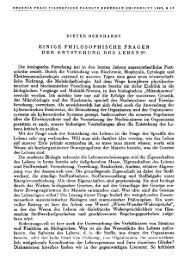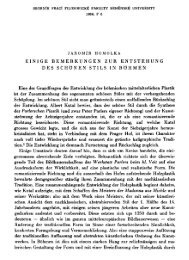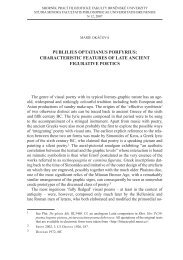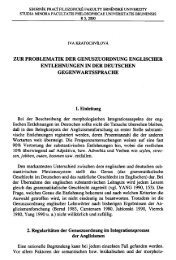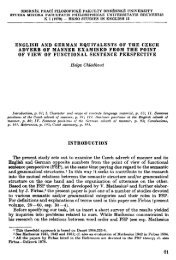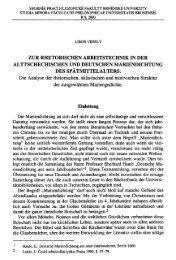M N E M A V L A D I M I R G R O H (1964 ...
M N E M A V L A D I M I R G R O H (1964 ...
M N E M A V L A D I M I R G R O H (1964 ...
You also want an ePaper? Increase the reach of your titles
YUMPU automatically turns print PDFs into web optimized ePapers that Google loves.
THE SENSE OF THE VICTORIA FORMULAE39decisive victory obtained in the critical period over the people, in the very heartof whose dwellings the inscription was engraved, but also by the fact that thevictory of the two Augusti is proved by a new imperatorial acclamation theywere honoured with, and just in the same space of time the inscription must bedated to, i. e. A. D. 179. 3It goes without saying that the case of the Trencin inscription is quite unique.It is hardly conceivable that another inscription of an equal kind could be found,enabling us to determine the chronology of the incident recorded in it, as well asto insert it into the corresponding political situation with so great a precision.The next specimen, most approaching the precedent by its wording, VictoriaeCommod[i objhonorem [Ul]p. Maximus [et Ul]p. Avitus [II v(iri)] i(ure)d(icundo), iis an inscription from the Dacian Ampelum; but it is almost completelyenigmatic, because of lack of parallel records, both of epigraphic andliterary kind. Owing to its uncertain chronology, it cannot be decided whichpeople it was, the victory over whom was recorded here. Some historians, beingat a loss for any other conception, guessed at a victory gained over the Dacians,as suggested by a mention in the Biography of Commodus (SHA, Comm. 13, 5),vied Daci — of course not over the free, independent Dacians, but over somerebels among the inhabitants of the Province of Dacia: in Dacia imperium eiusrecusantibus provincialibus.Any nearer evidence is missing also for the victory of the Emperors SeptimiusSeverus and Garacalla, hinted at in the inscription from Brjgetio (CIL III 4364,11 082), 5 offered, on June 9, 207, by L. Egnatius Victor, the legate of UpperPannonia, to the Victory of the Emperors and the local garrison, the Legio IAdiutrix; therefore we have no chance, for the moment, to decide whether itconcerned a victory obtained perhaps some time in Africa (M. Platnauer, TheLife and Reign of the Emperor L. Septimius Severus. London 1918, 205, n. 4;Ritterling, Legio, in R.-E. XII. 2, 1925, 1398) or, more probably, the fightingson the Middle Danube (M. Besnier, L'Empire Romain de l'avenement des Severesau Concil de Nicee [Histoire Romaine IV. 1.] Paris 1937, 40 sq.; A. Alfoldi,Budapest tortenete. Budapest 1942, 670, n. 1; L. Barkoczi, Archaeologia HungaricaXXXVI, 1957, 517), or an entirely other occasion (J. Fitz, Der Besuch desSeptimius Severus in Pannonien im Jahre 202 u. Z. Acta Archaeologica AcademiaeSciemtiarum Hungaricae XI, 1959, 255), either to ascertain whether the dativeform victoriae may be regarded as expressing a prayer to the goddess of victory,or thanks for the fulfilment of such a prayer and for the granting of a definitemilitary success.With this problem we meet also in the victorious formulae which are the leastdisputable at first sight: the prepositional expressions pro victoria and obvictoriam. All doubts about the function of the term in question as an appellativeand not the proper name of the goddess are removed by the circumstance that



